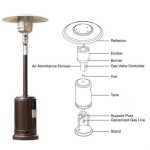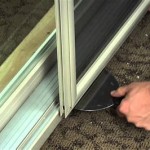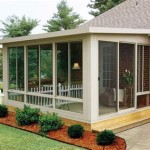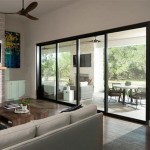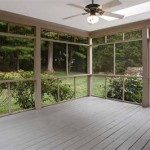Enhancing Your Outdoor Living Space: Patio Lighting Ideas
Outdoor lighting plays a crucial role in transforming a patio from a simple concrete slab into an inviting and functional extension of the home. Strategic patio lighting not only enhances the aesthetic appeal of the outdoor space but also contributes to safety and usability after sunset. Careful consideration of lighting types, placement, and control systems allows homeowners to create a personalized atmosphere that complements their lifestyle and architectural style.
The selection of appropriate patio lighting requires careful planning and evaluation of various factors. These considerations include the size and layout of the patio, the surrounding landscape, the intended use of the space, and the overall design aesthetic. Furthermore, awareness of energy-efficient options and relevant safety regulations is essential for creating a sustainable and compliant outdoor lighting plan.
Defining the Purpose and Ambiance
Before embarking on any patio lighting project, homeowners should carefully define the intended purpose and desired ambiance of the space. Is the patio primarily intended for dining, relaxation, entertaining, or all three? The answer to this question will significantly influence the type and intensity of lighting required. For example, a patio used for dining may necessitate brighter, more focused lighting over the table, while a relaxation space might benefit from softer, ambient lighting.
Consider the desired mood and atmosphere. Do you envision a romantic and intimate setting, a lively and vibrant gathering space, or a tranquil and serene retreat? Different lighting techniques and fixtures can evoke various emotional responses. Warm-toned lighting, for example, is generally associated with relaxation and intimacy, while cooler-toned lighting can create a more energetic and modern atmosphere.
The architectural style of the home and the surrounding landscape should also be taken into account. The lighting should complement the existing design elements and enhance the overall aesthetic appeal of the property. Consider the colors, textures, and materials used in the patio’s construction and select lighting fixtures that harmonize with these elements. The landscape, including trees, shrubs, and flowerbeds, can also be incorporated into the lighting design to create depth and visual interest.
Exploring Lighting Fixture Options
A wide array of lighting fixtures is available for outdoor patios, each offering unique advantages in terms of aesthetics, functionality, and energy efficiency. Selecting the right fixtures is crucial for achieving the desired lighting effect and creating a visually appealing outdoor space. Several common options include:
String Lights: String lights, also known as fairy lights or bistro lights, are a popular choice for creating a festive and inviting atmosphere. They are available in various lengths, bulb styles, and colors, and can be easily strung across a patio, pergola, or tree branches. String lights are often used to provide ambient lighting and create a warm and romantic ambiance.
Lanterns: Lanterns provide a classic and elegant lighting solution for patios. They are available in a range of styles, from traditional gas lanterns to modern electric lanterns, and can be hung from ceilings, placed on tables, or mounted on walls. Lanterns can be used to provide both ambient and accent lighting, and their enclosed design offers protection from the elements.
Path Lighting: Path lighting is essential for safety and wayfinding on patios, especially those with steps, uneven surfaces, or winding pathways. Path lights can be installed along walkways, driveways, and planting beds to illuminate the path and prevent accidents. They are typically low-voltage fixtures that provide soft, diffused light.
Spotlights and Floodlights: Spotlights and floodlights are used to highlight specific features of the patio or landscape, such as architectural details, sculptures, or trees. Spotlights provide a focused beam of light, while floodlights offer a broader area of illumination. These fixtures can be used to create dramatic effects and add visual interest to the outdoor space.
Deck Lights: Deck lights are designed to be installed directly into the surface of a deck or patio, providing subtle and unobtrusive illumination. They are typically low-voltage fixtures that are flush-mounted with the deck boards, creating a seamless and integrated lighting solution. Deck lights are often used to highlight the edges of a deck or patio and provide ambient lighting for walkways and seating areas.
Wall Sconces: Wall sconces are mounted on walls to provide both ambient and accent lighting. They are available in a variety of styles and finishes, and can be used to complement the architectural style of the home. Wall sconces are often used to illuminate doorways, patios, and outdoor living spaces.
Post Lights: Post lights are mounted on posts or columns to provide general area lighting. They are often used to illuminate driveways, walkways, and outdoor living spaces. Post lights are available in a variety of styles and heights, and can be used to create a traditional or modern look.
When selecting lighting fixtures, consider their durability, weather resistance, and energy efficiency. Opt for fixtures that are specifically designed for outdoor use and are made from materials that can withstand the elements. LED lighting is generally the most energy-efficient option, offering long-lasting performance and significant cost savings compared to traditional incandescent or halogen bulbs.
Optimizing Lighting Placement and Control
The placement of lighting fixtures is just as important as the type of fixtures selected. Strategic placement can enhance the aesthetic appeal of the patio, improve safety and security, and create a more functional and inviting outdoor space. Consider the following guidelines when planning the layout of your patio lighting:
Layering Lighting: Employ a layered lighting approach, combining ambient, task, and accent lighting to create a balanced and visually appealing effect. Ambient lighting provides overall illumination, task lighting provides focused light for specific activities, and accent lighting highlights architectural features or landscaping elements.
Highlighting Focal Points: Use spotlights or floodlights to highlight focal points, such as a water feature, sculpture, or specimen tree. This will draw attention to these elements and add visual interest to the outdoor space.
Illuminating Pathways: Install path lighting along walkways and steps to ensure safe and easy navigation, especially at night. Proper path lighting can prevent accidents and improve the overall accessibility of the patio.
Avoiding Light Pollution: Minimize light pollution by using shielded fixtures that direct light downward and avoid upward-facing lights that can illuminate the sky. Choose fixtures with low light output and aim them appropriately to avoid glare and light trespass onto neighboring properties.
Incorporating Controls: Implement lighting controls such as dimmers, timers, and motion sensors to optimize energy efficiency and create a more customized lighting experience. Dimmers allow you to adjust the brightness of the lights to suit the mood and activity, while timers can automatically turn the lights on and off at predetermined times. Motion sensors can activate lights only when movement is detected, providing added security and energy savings.
Considering Seasonal Adjustments: Keep in mind that lighting needs may change with the seasons. During the winter months, when daylight hours are shorter, you may need to increase the overall level of lighting on the patio. In the summer months, when outdoor activities tend to extend later into the evening, you may want to adjust the lighting to create a more relaxed and inviting atmosphere.
Professional Installation: For complex lighting projects, consider hiring a qualified electrician or landscape lighting professional. A professional can help you design and install a safe and efficient lighting system that meets your specific needs and preferences. They can also ensure that the lighting complies with all relevant building codes and safety regulations.
By carefully considering the purpose and ambiance of your patio, exploring the various lighting fixture options, and optimizing the placement and control of the lighting, you can create an outdoor space that is both beautiful and functional. Strategic patio lighting can transform your outdoor living area into an inviting and enjoyable extension of your home, allowing you to relax, entertain, and appreciate the beauty of your surroundings long after the sun has set.

19 Stylish Outdoor Lighting Ideas The Best Patio

28 Backyard Lighting Ideas How To Hang Outdoor String Lights

Top 5 Backyard Lighting Ideas Mike S Landscape

Outdoor Lighting Ideas Lowe S

Simple Backyard Lighting Ideas 5 Tips To Create A Cozy Glow

Outdoor Led Lighting Ideas For Any Style Backyard

Backyard Lighting Ideas Homedepot Ca

Types Of Patio Lights Support Poles For Made From Rebar And Electrical Conduit Txbhlro Patiolight Backyard Lighting Outdoor

5 Summer Outdoor Lighting Ideas You Ll Love

5 Outdoor Patio Lighting Ideas
Related Posts

